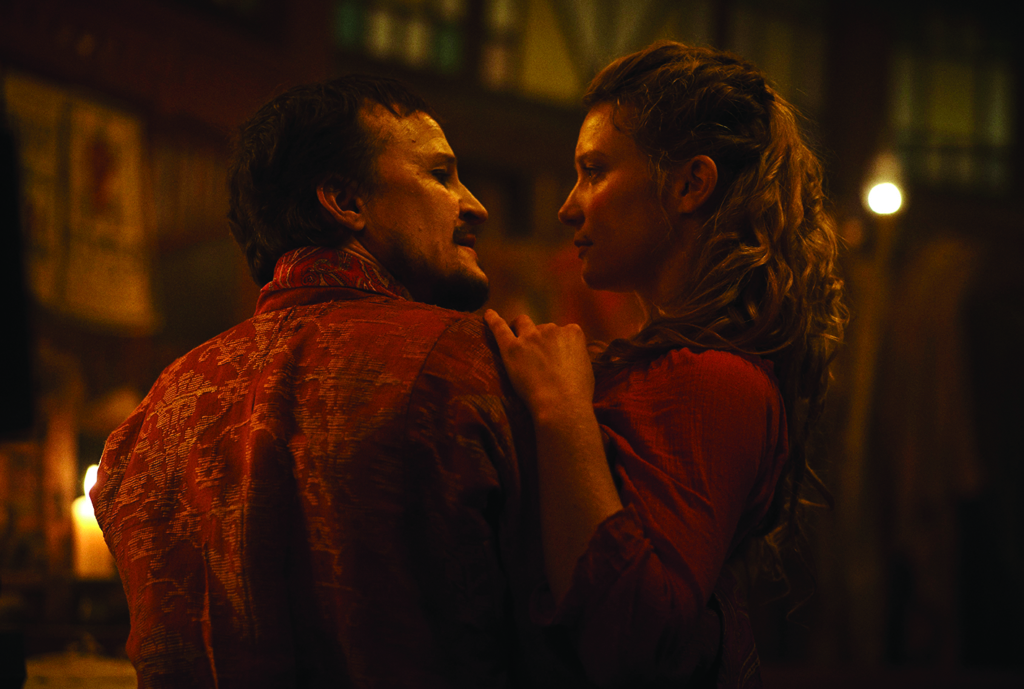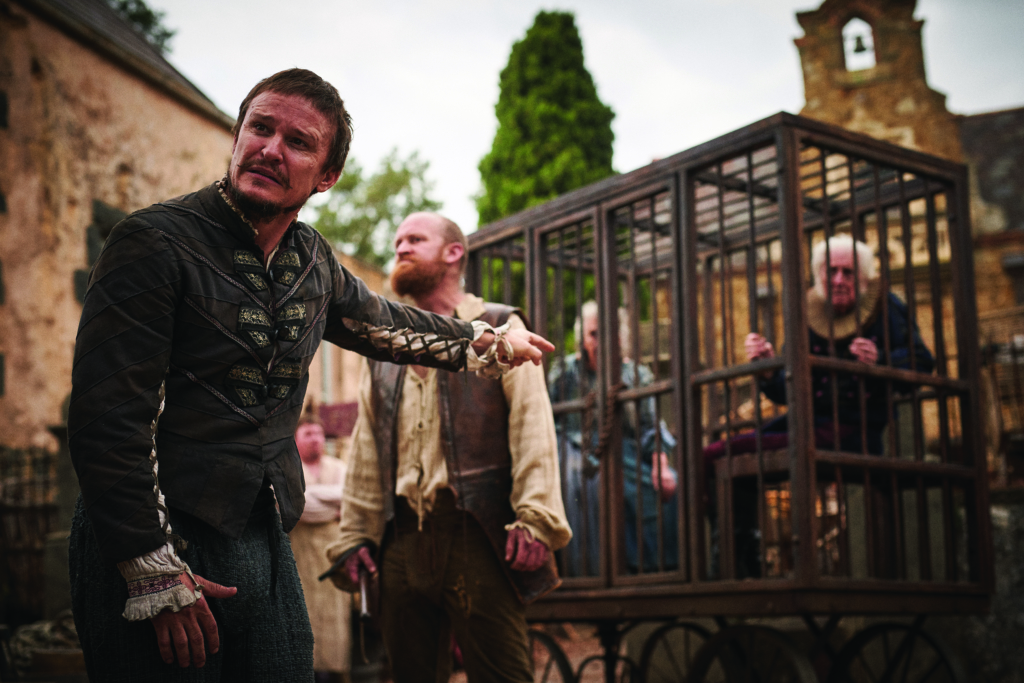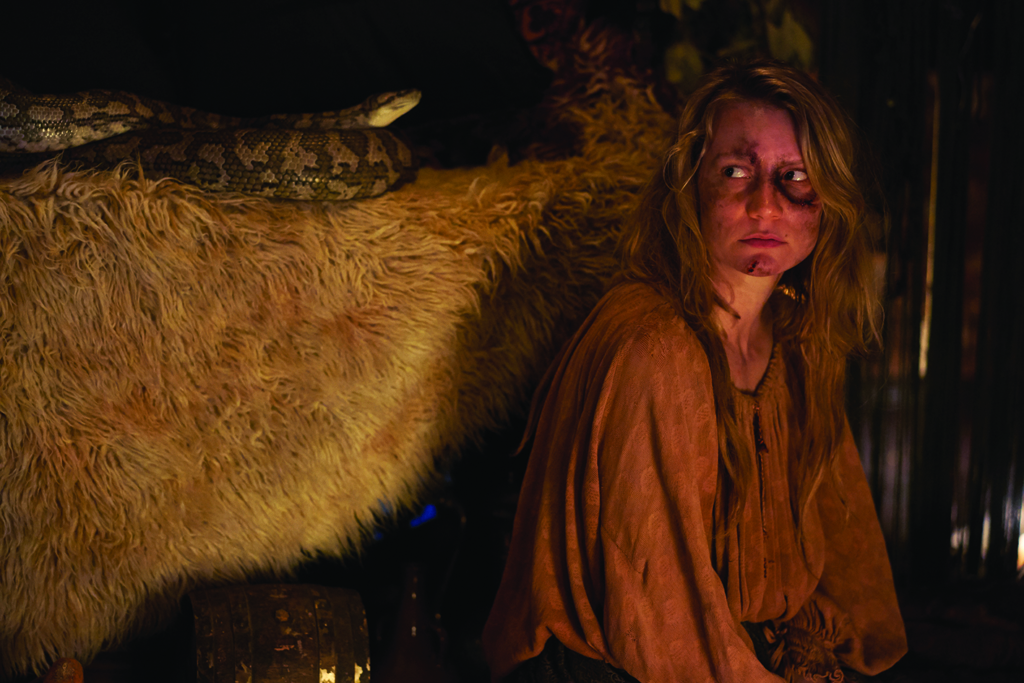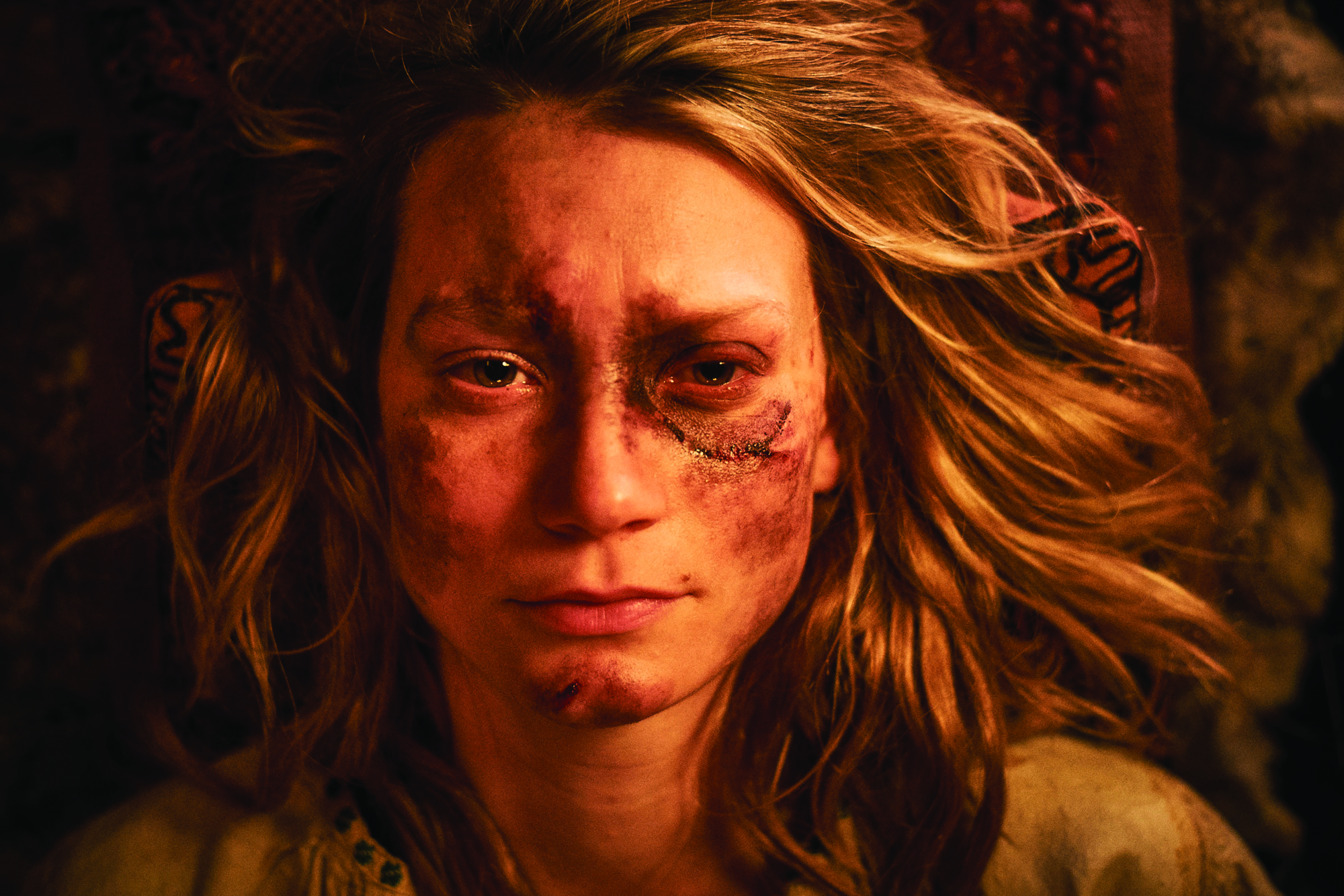When Judy & Punch premiered at the 2019 Sundance Film Festival, its creator – Sydney-based actor-turned-director Mirrah Foulkes – was nervous about how it would be received. She was a first-time filmmaker, few American audiences are familiar with the 400-year-old puppet show on which it is based and, even in the realm of film festivals, the resulting work was a genuine oddity. ‘I was nervous about it. It’s a weird film; its tone is unusual. It’s nutso!’ Foulkes laughs. Setting out to make Judy & Punch, the director harboured genuine ambitions for her debut: ‘I wanted to make a film that didn’t feel like any other film. I wanted it to feel unique and unusual and bold. And I wanted it to be fun.’
It’s to her great credit that Judy & Punch is all of those things. Her film is a strange, satirical, absurdist, magic-realist tragicomedy set in a suitably Grimm-fairytale village – Seaside, which is, in fact, nowhere near the sea – where superstition is rampant, violence is rife and women are, so often, the victims of both. It’s a ‘made-up origin story’ of Punch and Judy, the deathless tale of bickering spouses that traces its roots to marionettes used in sixteenth-century Italian theatre, and was first performed in England at the dawning of the Restoration, in 1662. Over time, it’d become a staple of any village fair or school fete in its adopted homeland, and is performed, still, to this day.[1]See ‘That’s the Way to Do It! A History of Punch and Judy’, Victoria and Albert Museum website, <http://www.vam.ac.uk/content/articles/t/thats-the-way-to-do-it!-a-history-of-punch-and-judy/>, accessed 24 July 2019. ‘It’s this weird puppet show that’s endured over centuries,’ Foulkes chimes, ‘that’s essentially about a man beating his wife up.’

And so Judy & Punch is both openly ridiculous (Foulkes acknowledges its ‘silliness’, and numerous critics have compared it to Monty Python[2]See, for example, Dennis Harvey, ‘Sundance Film Review: Judy & Punch’, Variety, 28 January 2019, <https://variety.com/2019/film/reviews/judy-punch-review-1203120254/>; and Leslie Felperin, ‘Judy & Punch: Film Review | Sundance 2019’, The Hollywood Reporter, 29 January 2019, <https://www.hollywoodreporter.com/review/judy-punch-review-1180663>, both accessed 24 July 2019.) and a serious study of violence – be it as a socially condoned weapon of domestic oppression, a morally righteous tool of vengeance or a storytelling trope, and be it in a motion picture or puppet show. Indeed, in her director’s statement, Foulkes suggests she was ‘drawn to using this strange, misogynistic puppet show to explore our contemporary obsession with violence’.[3]Mirrah Foulkes, ‘Director’s Statement’, in Seaside Production, Judy & Punch press kit, 2018, p. 3. Trying to balance the comic, the dramatic, the tragic, the metaphorical and the sociological with the desire to make something broadly entertaining, Foulkes tells me she felt like she was walking a tonal tightrope. But she was also hoping to make something unexpected, if not openly provocative, whose wackadoo ways could just as easily be loved as hated.
All of which is to say: Judy & Punch isn’t your regular Australian movie. For starters, there’s its storybook setting, which is theoretically seventeenth-century England but essentially timeless and placeless, a ‘slightly fantastic otherworld that [doesn’t] feel instantly recognisable’, in Foulkes’ words. Actors speak in a variety of English, Scottish and Irish accents, and deliver obscure or delightfully archaic idioms (‘niggardly’, ‘cunt-house’, ‘arse-worm’) while speaking with a modern bent, the screenplay showing no desire for verbal fidelity, or for the good taste of the conventional period piece. With nary a gum tree in sight – Foulkes ‘definitely didn’t want [the film] to feel Australian’ – it sure doesn’t look like a local production. But filming did take place in various locations in greater Melbourne: at Montsalvat, a historic artist colony in Eltham; at Overnewton Castle, not far from Melbourne Airport, in Keilor; and in the RJ Hamer Arboretum, a parkland comprised of exotic tree species in the Dandenong Ranges. The shoot was not just quick but ambitious: on top of the historical, European-ish setting, there were lots of children and animals. Foulkes was a debutante director, and all the prep in the world can’t train you for how to handle scenarios involving, say, ‘a kid that’s gonna have a breakdown and you lose half a day because they’re screaming, or a dog that’s terrified of your actor – both of which we had’.

Foulkes felt particularly emboldened in her vision by her producers, VICE Studios. Having screened Foulkes’ short films Dumpy Goes to the Big Smoke (2012) and Florence Has Left the Building (2014) on its web platform, VICE approached Foulkes – a member of the collective Blue-Tongue Films, which also includes her husband, David Michôd, along with the Edgerton brothers and others – about working together. One in-house idea VICE had was making a live-action Punch and Judy movie with a contemporary, feminist spin; wherever Foulkes wanted to take that idea, whatever she wanted to do, was left open. Having long established its corporate brand as edgy, confronting and obnoxious, VICE wanted her to push the envelope: ‘The only thing that they really required was that I was brave and bold,’ Foulkes says. This support – ‘they had more faith in me than I had in myself,’ she offers, ‘[which] was such a blessing as a first-time filmmaker’ – allowed her to be genuinely audacious, and to make a film unafraid of rattling or disturbing its audience. Given how common it is to see overly cautious, ‘safe’ productions on local screens, Judy & Punch makes one wish that more of Australia’s scant film-funding dollars went to genuinely idiosyncratic, challenging cinematic visions.
Of course, the rhetoric is always that Australian cinema is a reflection of what people are and aren’t willing to actually go and see. What’s particularly strong about Judy & Punch is the way viewers themselves are immediately indicted in their spectatorial complicity. The opening sequence follows behind a child, who dashes in from woodland fringes, through a busy town and into a pub (called McDrinky’s!), where a braying, boozy, badly toothed crowd has gathered to watch a bawdy puppet show performed by Mr Punch (Damon Herriman) and his wife, Judy (Mia Wasikowska). There’s lusty cheers for both ribald puns and, of course, the first depictions of domestic violence. At the end of this beginning (in which François Tétaz’s score, playing medieval motifs on electronic instruments, sets an incongruous tone), Foulkes and director of photography Stefan Duscio frame the crowd in a frontal tableau, with the film’s title banner overlaid in scarlet script. By situating its title not on its titular characters, but on the crowd watching them, Foulkes foregrounds that Judy & Punch is about the audience, the crowd, the mob – not just about those performing an entertainment, but those watching it. There’s a reflexive quality to both this opening and the film’s ending, the latter finding Punch alone, incarcerated, performing a sadly tragic puppet show and intoning the words, ‘Here, therein, is the story; it’s a very violent story,’ before the closing credit roll also shows old newsreels of real-life children watching Punch and Judy performances, at once delighted and traumatised. ‘There’s definitely meta layers to the film,’ says Foulkes, ‘in how we respond to violence on screen, and how audiences respond to violence on stage.’
Judy & Punch is both openly ridiculous … and a serious study of violence – be it as a socially condoned weapon of domestic oppression, a morally righteous tool of vengeance or a storytelling trope, and be it in a motion picture or puppet show.
The violence of the traditional Punch and Judy show is echoed in the violence of Judy & Punch. Mr Punch, it turns out, is charismatic and quick-witted, but full of darkness and self-loathing, and prone to debilitating bouts of drunkenness – depicted as neither roguish antihero nor simple villain. Having fallen on hard times, the pair have returned to Judy’s home town, Seaside, with their infant child – though provincial life is something that the self-styled ‘big-city’ performer clearly resents. He also resents the ease with which performing, magic and illusion – and, yes, there’s resonance here with cinema as its own form of sleight of hand – come to his wife. The fact that she’s happy to work behind the scenes while he fronts the show symbolises the power relationship in their marriage: he, the older, more educated man who whisked this small-town girl away; she, at the outset, in a more caring, subservient role.
At the opening, we find them at work, their show in better shape than their marriage. He’s committed to staying ‘straight and sober’ in hopes of returning to the London theatres, but, evidently, his sobriety is tenuous. Soon enough, he’s back on the sauce, failing to live up to his pledge to make only ‘good decisions’. Left alone to care for their child, he’s derelict in his duties. In a tragic scene played as mad slapstick – with the traditional Punch and Judy puppet-show elements of a persistent dog and stolen sausages – he ends up tripping and flinging their newborn out an open window to her death. Panicked, he burns the baby in a fiery oven, then drinks himself into oblivion. When Judy returns home, he initially dismisses her concerns for the child’s whereabouts (‘Not two minutes in the door, and straight to poor Punch with your nagging!’), before admitting to the tragedy. ‘I accidentally dropped the baby out the window,’ Punch sheepishly shrugs, ‘but what’s done is done, so I suppose we best move on with our lives.’ She’s outraged at both this unimaginable act and his greater failures, but he staves off her diatribe by way of that most familiar of Punch and Judy tropes: beating her with a big black stick. Here, though, it’s played not for laughs, but as an incident of horrifying violence, with the show’s most famous line – ‘That’s the way to do it!’ spat by Punch following the beating – sounding out a grim indictment of the audience’s long-running acceptance of this ‘gag’. Believing her to be dead, he wraps her body in a blanket and buries her beneath the pine needles of the nearby forest.

Whereas much of the film is fanciful, fantastical or ridiculous, the scenes of brutality in Judy & Punch are presented with a kind of observational realism, Duscio’s camera creating intimacy through its handheld tremors. Foulkes essentially inverts – and, in turn, subverts – tropes by way of her narrative’s radical swing: the ultimate tragedy of a child’s death is deployed as comedy, while the slapstick act eliciting comedy in Punch and Judy is now tinged with tragedy and modern-day darkness. This is Foulkes ‘contemplating the nature of violence in entertainment, and how it’s existed since gladiatorial days’. While acknowledging that ‘it makes sense that we’re drawn to the dramatics and theatrics of violent acts’, the director is also keenly aware of how it’s often depicted for the simple ‘thrills’ of an audience. She also emphasises how, in stories, true-crime podcasts and society itself, the victims of violence are so often women: ‘I was interested in the relationship between gender and violence.’
The feminist rewriting of the patriarchal puppet show manifests when Judy wakes up in the woods, buried alive, and, like the blood-spattered Bride (Uma Thurman) in Kill Bill: Volume 1 (Quentin Tarantino, 2003), ‘comes back’ from the dead. She finds herself among a tribe of outcasts, mostly women and children, who dwell in an ad-hoc community – if not a commune, with all that that word evokes – in the forest. There, she can gather a veritable army for an uprising, and plot her grand revenge on Punch and the society that’s empowered him.
Judy & Punch is about the audience, the crowd, the mob – not just about those performing an entertainment, but those watching it … ‘There’s definitely meta layers to the film,’ says Foulkes, ‘in how we respond to violence on screen, and how audiences respond to violence on stage.’
Back in the village, Punch has pinned the deaths of his wife and child on a pair of ageing, infirm servants, Maid Maude (Brenda Palmer) and Scaramouche (Terry Norris). They’re due to be executed for the murders, based on nothing other than Punch having decreed that they have ‘the devil’s look about them’. Just as violent puppet shows are family entertainment in Seaside, so are public hangings, stonings and witch burnings. Judy & Punch’s great social-satirical targets are moral panic and hypocrisy, the way self-appointed moral guardians decide what has contravened social values, who deserves to be punished and how.
With a kind of high-comic tone reminiscent of The Simpsons’ skewering of witch trials in ‘Easy-Bake Coven’, a story from the 1997 anthology episode ‘Treehouse of Horror VIII’, we find a town of parochial simpletons – who’ve built a town called Seaside a ‘three-day mule ride’ from the ocean – pointing fingers at everyone else, judging so as to avoid being judged. Here, merely having a rash or gazing too long at the moon can be a sign of witchcraft, and this moral panic around ‘feminine’ sorcery has proved deleterious to society: the village’s erstwhile sole medical professional, Dr Goodtime (Gillian Jones), has been banished, surviving among the outcasts. They dwell in the woods, which is described by villagers – as in fairytales – as a spectre, ‘the black forest yonder’ used to scare not only children but the whole populace. This sanctimony is embodied in the figure of Mr Frankly (Tom Budge), self-appointed mayor and moral guardian, whose pious sermons on the perils of evil feel just as current today as they do in this storybook world. ‘I would laugh as I was writing that stuff,’ Foulkes admits, ‘because there’s so many obvious parallels, politically, to that kind of spouting of bullshit [nowadays], basically.’

It’s impossible to bring up witch-hunts and angry-mob justice without summoning the modern-day equivalent: internet outrage. With this, too, come public shaming and social exclusion, wherein a kind of collective bloodlust wins out over cold reasoning or proper legal channels.[4]For more on ‘call-out culture’ and online shaming, see Jon Ronson, So You’ve Been Publicly Shamed, Riverhead Books, New York, 2015. In Judy & Punch, Mr Frankly dismisses due process as ‘an outlandish social experiment’ – and, when Judy, at the moment of her great retribution, warns the crowd, ‘Tomorrow, the witch might be you!’ it feels like an indictment of morality policing and mob mentality not just in the film’s fairytale yore, but also in the online now.
This is in keeping with a greater theme of Judy & Punch: that the great horrors of invoking the Punch and Judy show lie not in digging into the distant time that birthed it, but in the realisation that we’ve yet to transcend its tropes, themes and troubling elements. That’s why the symbolic village of Seaside, in the film, exists in neither past nor present: dark, depraved, unjust societies aren’t the province of the past, but things that have persisted even in our supposedly more enlightened present. ‘It’s tragic how much of that historical stuff is still relevant today,’ Foulkes says. ‘That was the most terrifying part of the research I did: realising that all of this shit’s still happening. I wasn’t horrified by the origins of Punch and Judy, but by the lack of evolution in contemporary society.’
Endnotes
| 1 | See ‘That’s the Way to Do It! A History of Punch and Judy’, Victoria and Albert Museum website, <http://www.vam.ac.uk/content/articles/t/thats-the-way-to-do-it!-a-history-of-punch-and-judy/>, accessed 24 July 2019. |
|---|---|
| 2 | See, for example, Dennis Harvey, ‘Sundance Film Review: Judy & Punch’, Variety, 28 January 2019, <https://variety.com/2019/film/reviews/judy-punch-review-1203120254/>; and Leslie Felperin, ‘Judy & Punch: Film Review | Sundance 2019’, The Hollywood Reporter, 29 January 2019, <https://www.hollywoodreporter.com/review/judy-punch-review-1180663>, both accessed 24 July 2019. |
| 3 | Mirrah Foulkes, ‘Director’s Statement’, in Seaside Production, Judy & Punch press kit, 2018, p. 3. |
| 4 | For more on ‘call-out culture’ and online shaming, see Jon Ronson, So You’ve Been Publicly Shamed, Riverhead Books, New York, 2015. |





